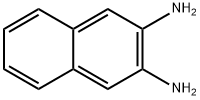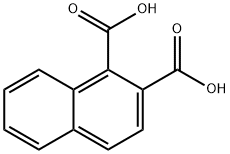2,6-NAPHTHALENEDICARBOXYLIC ACID
- CAS NO.:1141-38-4
- Empirical Formula: C12H8O4
- Molecular Weight: 216.19
- MDL number: MFCD00004105
- EINECS: 214-527-0
- SAFETY DATA SHEET (SDS)
- Update Date: 2024-12-18 14:15:30

What is 2,6-NAPHTHALENEDICARBOXYLIC ACID?
Chemical properties
BEIGE POWDER
The Uses of 2,6-NAPHTHALENEDICARBOXYLIC ACID
2,6-naphthalenedicarboxylic acid is an important product for the manufacture of high strength and excellent dyeing properties of polyester fibers and F class insulation material, is an important monomer performance PEN, PBN, liquid crystal polymer (LCP) and polyurethane resin pharmaceutical and fine chemicals raw material.
The Uses of 2,6-NAPHTHALENEDICARBOXYLIC ACID
A polybasic acid intended for use as components of resinous and polymeric coatings that contact food.
The Uses of 2,6-NAPHTHALENEDICARBOXYLIC ACID
2,6-Naphthalenedicarboxylic acid (H2ndc) can be used in the formation of metal-organic coordination polymers (MOCPs) for potential applications in various fields such as adsorption, separation, and magnetism. It can also be used as a monomer in the production of polyesters. H2ndc can also be used in the synthesis of a metal-organic framework (MOF), which can further be used as a drug carrier.
What are the applications of Application
Used to prepare poly-2,6-naphthalenes by metal-catalyzed polymerization
Definition
ChEBI: Naphthalene-2,6-dicarboxylic acid is a dicarboxylic acid. It derives from a hydride of a naphthalene.
General Description
This product has been enhanced for energy efficiency.
Flammability and Explosibility
Not classified
Properties of 2,6-NAPHTHALENEDICARBOXYLIC ACID
| Melting point: | >300 °C (lit.) |
| Boiling point: | 316.6°C (rough estimate) |
| Density | 1.5 |
| refractive index | 1.7080 (estimate) |
| storage temp. | Sealed in dry,Room Temperature |
| solubility | very faint turbidity in hot Pyridine |
| form | Powder |
| pka | 3.69±0.30(Predicted) |
| color | white |
| Water Solubility | 3μg/L at 20℃ |
| BRN | 2051257 |
| CAS DataBase Reference | 1141-38-4(CAS DataBase Reference) |
| EPA Substance Registry System | 2,6-Naphthalenedicarboxylic acid (1141-38-4) |
Safety information for 2,6-NAPHTHALENEDICARBOXYLIC ACID
| Signal word | Warning |
| Pictogram(s) |
 Exclamation Mark Irritant GHS07 |
| GHS Hazard Statements |
H315:Skin corrosion/irritation H319:Serious eye damage/eye irritation |
| Precautionary Statement Codes |
P264:Wash hands thoroughly after handling. P264:Wash skin thouroughly after handling. P280:Wear protective gloves/protective clothing/eye protection/face protection. |
Computed Descriptors for 2,6-NAPHTHALENEDICARBOXYLIC ACID
New Products
(S)-3-Aminobutanenitrile hydrochloride 4-Methylphenylacetic acid N-Boc-D-alaninol N-BOC-D/L-ALANINOL Tert-butyl bis(2-chloroethyl)carbamate 3-Morpholino-1-(4-nitrophenyl)-5,6-dihydropyridin- 2(1H)-one Furan-2,5-Dicarboxylic Acid Tropic acid 1-Bromo-3,5-Di-Tert-Butylbenzene S-2-CHLORO PROPIONIC ACID ETHYL ISOCYANOACETATE 2-Bromo-1,3-Bis(Dimethylamino)Trimethinium Hexafluorophosphate 4-IODO BENZOIC ACID 3-NITRO-2-METHYL ANILINE 1-(2,4-DICHLOROPHENYL) ETHANAMINE (2-Hydroxyphenyl)acetonitrile 4-Bromopyrazole 2-(Cyanocyclohexyl)acetic acid 4-methoxy-3,5-dinitropyridine 1-(4-(aminomethyl)benzyl)urea hydrochloride 2-aminopropyl benzoate hydrochloride diethyl 2-(2-((tertbutoxycarbonyl)amino) ethyl)malonate tert-butyl 4- (ureidomethyl)benzylcarbamate Ethyl-2-chloro((4-methoxyphenyl)hydrazono)acetateRelated products of tetrahydrofuran








You may like
-
 2,6-Naphthalenedicarboxylic Acid CAS 1141-38-4View Details
2,6-Naphthalenedicarboxylic Acid CAS 1141-38-4View Details
1141-38-4 -
 Naphthalene-2,6-dicarboxylic acid CAS 1141-38-4View Details
Naphthalene-2,6-dicarboxylic acid CAS 1141-38-4View Details
1141-38-4 -
 2,6-Naphthalenedicarboxylic acid, 99% CAS 1141-38-4View Details
2,6-Naphthalenedicarboxylic acid, 99% CAS 1141-38-4View Details
1141-38-4 -
 2,6-Naphthalenedicarboxylic acid CAS 1141-38-4View Details
2,6-Naphthalenedicarboxylic acid CAS 1141-38-4View Details
1141-38-4 -
 2,6-Naphthalenedicarboxylic acid CAS 1141-38-4View Details
2,6-Naphthalenedicarboxylic acid CAS 1141-38-4View Details
1141-38-4 -
 2,6-Naphthalenedicarboxylic acid CAS 1141-38-4View Details
2,6-Naphthalenedicarboxylic acid CAS 1141-38-4View Details
1141-38-4 -
 14714-50-2 (2-Hydroxyphenyl)acetonitrile 98+View Details
14714-50-2 (2-Hydroxyphenyl)acetonitrile 98+View Details
14714-50-2 -
 118753-70-1 98+View Details
118753-70-1 98+View Details
118753-70-1